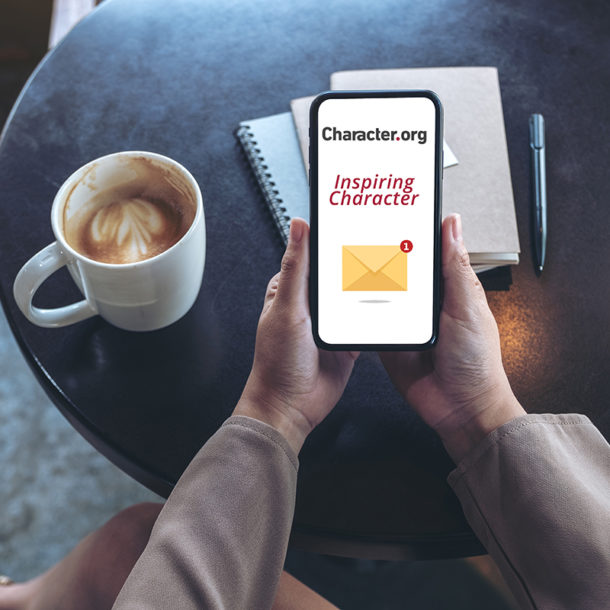By Dr. Arthur Schwartz
This spring Character.org featured a series of articles, podcasts, and webinars under the banner “Ethics in Action.” Supported by a grant from The School for Ethical Education, the series explored a range of concepts and practices to foster integrity and ethical behavior in all students.
I learned a lot from the series. For example, many of the experts and practitioners deepened my understanding of the term “moral compass.” They offered useful approaches and strategies for students to not only practice but also to reflect on the character strengths that are shaping and strengthening their moral compass.
Today, I want to explore with you one term that was mentioned numerous times throughout the series: commitment. For example, several of the experts emphasized that young people who have made a commitment to being honest or caring are far more likely to resist the pressures to lie or act selfishly, compared to those who have not intentionally made that commitment.
Yet what do we know about commitment? What are the building blocks of commitment? How do our commitments shape our habits and behaviors? Our identity and character?
Commitment has been studied across many domains, ranging from psychology and philosophy to relationship studies and religion. For example, researchers within the field of organizational behavior have defined commitment as a “force that binds an individual to a course of action that is of relevance to a particular target.” Another common definition suggests that commitment is the “pledging or binding of an individual to behavioral acts.”
The term commitment conjures an entire family of mental images. Some of us have made a commitment to a particular profession while others have made a marriage or a faith commitment. My own research shows that our commitments can be placed in one of six categories:
- Commitments to people (family, friends, marriage)
- Commitments to personal achievements (career, aspirations)
- Commitments to personal growth (physical fitness, self-understanding)
- Commitments to values and principles (honesty, fairness, compassion)
- Commitments to groups (volleyball team, coding club)
- Commitment to ultimate concerns (God, Diety)
For most of us, including our students, balancing our various commitments is a perennial challenge. The ongoing effort to integrate or “harmonize” our commitments is certainly more complicated and challenging than the life of a person who is committed to one goal only.
There are also people of all ages who too easily break their commitments, almost habitually so. They seem to lack the motivation to live their commitments on a day-to-day basis. Of course, we also need to recognize that there are a few people of all ages who we can only describe as “commitment prodigies” because they seem without effort to make and keep their commitments with exceptional resoluteness.
Do our commitments make a difference?
Here’s what we know. Researchers who have examined the relationship between goal commitment and performance have found strong evidence that the level of our commitment to a goal is a significant variable in predicting goal success or failure (for example, commitment is a strong mediating factor in smoking cessation and weight loss). We also know that a person’s level of commitment to their job, organization, or career strongly correlates with turnover, absenteeism, job satisfaction, and performance.
But the empirical study of commitment does not seem to fully capture the power of commitment. We know from biographies and personal narratives that commitments:
- Give us direction
- Motivate and energize us
- Shape our behavior and actions
- Change us
- Place demands on us
- Help us know when to take a stand or show resolve
- Offer us meaning and purpose
- Form and shape our identity
- Reveal our character
The Structure of Commitment
There seems to be seven discrete features that form the structure of commitment. That is, for any “object” of commitment (X), the seven features listed below appear to be essential for that particular commitment to fully develop and mature. These features are:
- Belief – I believe in X.
- Care – I care about X.
- Declaration – I make an intentional, often visible commitment to X.
- Practice – I practice the habits and virtues of X.
- Challenges – I am ready for the challenges I will face in my commitment to X.
- Persistence – I persist in my commitment to X, even in the face of setbacks.
- Identity – Over time, X becomes a part of my identity.
4 Ways to Help Students Develop Their Commitment Muscles
I believe we can build “commitment muscle” in ways analogous to developing physical muscle. Below are 4 exercises to help your students develop and hone their commitments:
Exercise #1
Encourage students to write about their commitments
Share with your students the six different commitment categories (see above) and ask them to write down 2 or 3 commitments they have made. As their teacher, please look out for “borrowed” rather than “owned” commitments. Help your students recognize and understand that no one can impose a commitment upon them. Put simply, their commitments are more than simply “walking the talk.” Their commitments are about determining what their talk should be about.
Exercise #2
Invite students to develop their own “if/then” commitment scripts
No one has an honesty “trait.” Rather, we possess skills and behavioral tendencies (“scripts”) that we activate during situations. Ask your students to develop and practice using specific words or behaviors during situations when they know their commitments will be tested (e.g., a peer pressure moment). These “if/then” scripts are a critical component to helping your students show fidelity to their commitments.
Exercise #3
Ask students to share with each other the images, stories, and rituals that speak to their commitments
Images matter. We all have mental pictures of people who are our commitment role models. Stories can also fuel our commitments. People have also developed various “commitment rituals” that express and embody their commitments (e.g., running a race each year to raise money for a cause they care about). Invite your students to share with each other the images, stories, and rituals that nourish their commitments.
Exercise #4
Ask students to explain who is holding them accountable for their commitments
We have coaches for sports and non-athletic teams (such as the chess or debating teams) because we know that coaching makes a difference in performance. Every student should have their own “accountability coach” and be able to explain how this person is helping them to be their best possible self.
There is so much we still don’t know about the nature of commitment. For example, does a person’s age matter? Does a person’s need for achievement, affiliation, or autonomy make a difference? Do environmental factors and family structure matter?
What we do know is that there is a dynamic relationship between commitment and integrity. If integrity is being true in word and deed to a set of values and principles, then a person of integrity should strive to show fidelity to their commitments, whether their commitments are personal or ethical.
Finally, I believe we are most alive when we’re listening to the “call” of our commitments. There is a lot of wisdom to the perspective that if memory is the mental organ of our past…commitment is the mental organ of our future.
“Ethics in Action” Series
- Jason Stephens webinar on why people lie to themselves
- Interview with Amy Meurs on how service learning can make a difference in the lives of students
- Interview with David Wangaard on how the Tri-Factor Model for Ethical Functioning can help students develop their own moral compass
- Interview with Phil Brown on developing an intentional culture of belonging that reaches all students and parents
- Interview with Karen Bohlin on how students and school leaders can develop the skills and dispositions of practical wisdom
- Interview with Kevin Basik on why honor codes work
- Interview with Mark Liston
- Interview with Matt Davidson
- Article by David Wangaard on Using Ethical Dilemmas in the Classroom







0 Comments